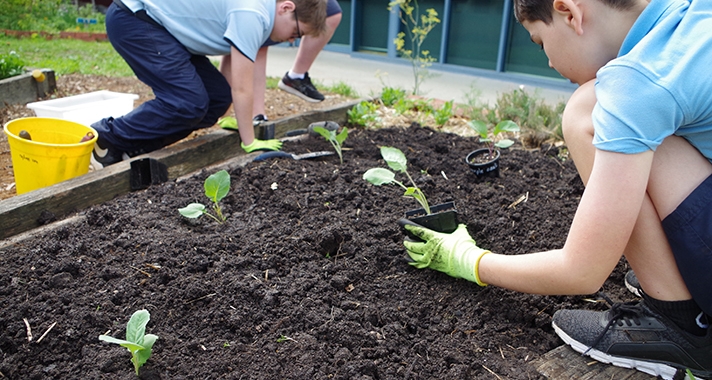Introducing the 10 Program Fundamentals

We are encouraged and inspired by the diversity of our kitchen garden community every day. We hear from schools and services across the country who have taken the Pleasurable Food Education Philosophy on board and applied it to their own context. Programs have been adapted to suit the needs and character of a school or service based on their unique setting, resources and community.
The Foundation team have been busy developing 10 program fundamentals, which are designed to support you in implementing your kitchen garden program wherever you are in your journey. Working at your own pace to achieve the fundamentals will ensure your students and school community are experiencing the kitchen garden program at its best. Remember: start small, work with what you have and use the program fundamentals to guide you in building a successful and sustainable program.
While there's no one-size-fits-all approach, a best-practice Stephanie Alexander Kitchen Garden Program is underpinned by the following 10 program fundamentals (examples interpreting each fundamental follow underneath).
1. Commitment to the philosophy of pleasurable food education
Pleasurable food education is a fun, hands-on approach to teaching students of all ages about growing, harvesting, preparing and sharing fresh, seasonal, delicious food. Kitchen garden programs are most effective when staff and the community understand and embrace this approach.
2. A team of at least two people coordinating the kitchen garden program
It’s ideal for your school or service to have two kitchen garden coordinators for the program. They could be any staff member or, in some cases, parents or volunteers invested in running the program. The key is that the coordinators, or team, are the central contacts and known as the ‘go-to’ people for the kitchen garden program.
3. A productive food garden
The cycle of growing, harvesting, preparing and sharing begins here. In the garden, students aim to grow as much seasonal produce as possible and carry the fresh harvest into the kitchen. Crops are displayed on a harvest table, which provides a tangible link between the garden and kitchen.
4. A kitchen and dining space
The kitchen space can be as simple or purpose-built as your resources allow, but the focus should be on home-style so that the students feel welcome in the space and can easily transfer their learnings and skills to the home.
5. Regular garden classes
Regular garden classes give students the opportunity to learn how to grow produce and develop a practical understanding of the seasons, the weather and the environment. Over time, students discover how to build and maintain an organic garden, learn about healthy soil and find out how to make and use compost.
6. Regular kitchen classes
The cycle of growing, harvesting, preparing and sharing culminates in the kitchen and dining space. Here, students make and eat delicious dishes from the fresh vegetables, herbs and fruit they have grown. In regular kitchen classes, students develop a heightened awareness of food – where it comes from, how it’s grown, seasonality, the sensory nuances of taste, smell and texture, and the fun involved in cooking and dining at the shared table together.
7. Curriculum integration
A kitchen garden program is an excellent teaching tool for all learning areas of your curriculum and can be used to support curriculum and learning objectives. There are infinite opportunities to reinforce literacy, numeracy, science, the cross-curriculum priorities, environmental sustainability and so much more.
8. Whole-school/service approach
A whole-school or whole-service approach involves parents and families, teachers, students and the broader community working together to support, reinforce and participate in pleasurable food education. This could look like offering a diversity of fresh, seasonal food to students through the school canteen, incorporating your program into strategic and annual curriculum planning, and allowing the philosophy of pleasurable food education to inspire fundraising and other food-related initiatives.
9. Community engagement
To engage a community means to reach out to educators, students and their families, as well as local businesses, groups, organisations and councils who will also participate in, and benefit from, pleasurable food education. Take small steps to build community support.
10. A sustainable program
Your kitchen garden program will become an integral element of school/service life and is implemented in an ongoing way. The long-term sustainability of your program should guide your planning and implementation process. This ensures all students present and future get the full benefit of the program.
You can find the full definition of each of the 10 fundamentals on the Shared Table for primary and secondary years here and for early childhood services here.
We’re here to help.
We’ve been developing a new support tool we can’t wait to share with you. The tool will help you work towards achieving these fundamentals and support you on your way to establishing a best-practice program — in your own time and at your own pace, in the way that best works for your community. We are here to provide the inspiration, information, professional development and support for you to deliver pleasurable food education. We want to see all children experiencing the joy of digging in the garden, growing and harvesting fresh veggies, smelling and tasting the food they prepare, and sharing the experience with their classmates and helpers.
If you have questions about the program fundamentals please don’t hesitate to contact our Support Team on 13000 SAKGF (13000 72543) or support@kitchengardenfoundation.org.au
< Back to Latest News
